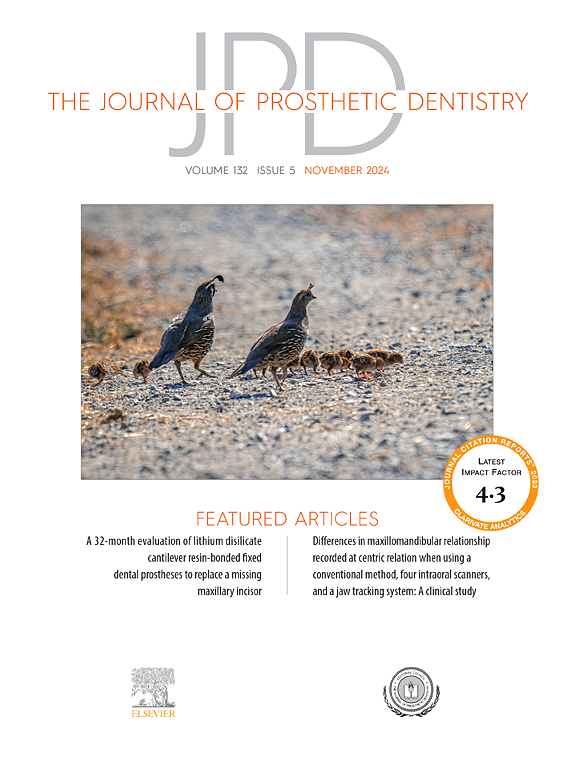整合光学相干断层扫描和口腔内扫描提高龈下终点线真实性:比较分析。
IF 4.8
2区 医学
Q1 DENTISTRY, ORAL SURGERY & MEDICINE
引用次数: 0
摘要
问题陈述:口腔内扫描牙龈下终点线而没有牙龈移位线可能会影响固定义齿的准确性。光学相干层析成像(OCT)的集成可以克服这一限制,但还需要进一步的研究。目的:本体外研究的目的是比较口腔内OCT系统和IOS系统在牙龈下终点线牙齿准备中获得的扫描数据的准确性。材料与方法:拔除上颌左中切牙,制备氧化锆冠。将制备好的牙齿嵌套在折光率与牙龈组织相似的硅胶人工牙龈模型中。终点线龈下深度标准化在0.50 ~ 0.70 mm之间。采用4种方法进行扫描:使用实验室扫描仪获得CAD参考模型(CRM),使用IOS (i700;MEDIT)无牙龈组(IOSO组),植入人工牙龈的IOS组(IOSG组),以及将龈下终点线的OCT扫描与IOSG数据集成的数据集(OCT组)。每组15例(n=15)。使用CRM数据集作为参考,并对IOSO、IOSG和OCT数据集进行最佳拟合校准。终点线的真实性是通过测量相对于CRM数据建立的虚拟平面上预定义点的偏差来评估的。此外,通过计算CRM数据集的整个点云的偏差来评估三维(3D)真实性。采用Kruskal-Wallis检验进行统计学分析(α= 0.05)。结果:IOSO组(中位数:12.5µm;四分位数间距[IQR]: 10.5)和OCT组(中位数:17.3µm;IQR: 16.7)与IOSG组相比,偏差明显降低(中位数:109.4µm;IQR: 235.1) (P.05),而IOSG组在终点线的偏差最大(P.05)。结论:与传统的有牙龈干扰的口腔内扫描相比,集成口腔内OCT系统提高了龈下终点线扫描的准确性。本文章由计算机程序翻译,如有差异,请以英文原文为准。
Integration of optical coherence tomography and intraoral scanning for enhanced subgingival finish line trueness: A comparative analysis
Statement of problem
Intraoral scanning of subgingival finish lines without gingival displacement cords may compromise the accuracy of fixed dental prostheses. The integration of optical coherence tomography (OCT) may overcome this limitation, but further research is required.
Purpose
The purpose of this in vitro study was to compare the trueness of scan data obtained from an intraoral OCT system and an IOS for tooth preparations with subgingival finish lines.
Material and methods
A maxillary left central incisor was extracted and prepared for a zirconia crown. The prepared tooth was embedded in an artificial gingival model composed of silicone, with a refractive index similar to that of gingival tissue. The subgingival depth of the finish line was standardized between 0.50 and 0.70 mm. Scanning was performed using 4 methods: a CAD reference model (CRM) obtained using a laboratory scanner without gingiva, an IOS (i700; MEDIT) without gingiva (IOSO group), an IOS with artificial gingiva in place (IOSG group), and a dataset integrating OCT scans of the subgingival finish line with IOSG data (OCT group). Each group consisted of 15 specimens (n=15). The CRM dataset was used as the reference, and the best-fit alignment was performed for the IOSO, IOSG, and OCT datasets. The trueness of the finish line was assessed by measuring deviations at predefined points on virtual planes established relative to the CRM data. Additionally, 3-dimensional (3D) trueness was evaluated by calculating deviations across the entire point cloud of the CRM dataset. Statistical analysis was conducted using the Kruskal–Wallis test (α=.05).
Results
The IOSO group (median: 12.5 µm; interquartile range [IQR]: 10.5) and the OCT group (median: 17.3 µm; IQR: 16.7) exhibited significantly lower deviations compared with the IOSG group (median: 109.4 µm; IQR: 235.1) (P<.05). For 3D trueness, no significant difference was observed between the IOSO and IOSG groups (P>.05), while the IOSG group exhibited the highest deviation at the finish line (P<.05).
Conclusions
The integration of an intraoral OCT system improved the trueness of subgingival finish line scans compared with conventional intraoral scanning with gingival interference.
求助全文
通过发布文献求助,成功后即可免费获取论文全文。
去求助
来源期刊

Journal of Prosthetic Dentistry
医学-牙科与口腔外科
CiteScore
7.00
自引率
13.00%
发文量
599
审稿时长
69 days
期刊介绍:
The Journal of Prosthetic Dentistry is the leading professional journal devoted exclusively to prosthetic and restorative dentistry. The Journal is the official publication for 24 leading U.S. international prosthodontic organizations. The monthly publication features timely, original peer-reviewed articles on the newest techniques, dental materials, and research findings. The Journal serves prosthodontists and dentists in advanced practice, and features color photos that illustrate many step-by-step procedures. The Journal of Prosthetic Dentistry is included in Index Medicus and CINAHL.
 求助内容:
求助内容: 应助结果提醒方式:
应助结果提醒方式:


